Abstract
The authors discuss currently conducted research aimed at improving the planning and performance of search and rescue (SAR) operations at sea. The focus is on the selection of surface units in areas of high traffic density. A large number of ships in the area of distress can make the process of selection of best suited vessels longer. An analysis of features which may render a vessel unsuitable for the job, depending on the area and type of operation, has been conducted. Criteria of assessment and selection of ships have been described, preceded by an expert analysis. The selection process has been made using Multi-Criteria Decision Analysis (MCDA). The authors propose to apply officially available data from the Automatic Identification System (AIS)—a sensor for the ECDIS and other electronic chart systems—in the analysis of the availability of ships. Algorithms filtering available units have been built and applied in a simulation, using real AIS data, of one of the most common types of SAR operations. The method is proposed as an enhancement of decision support systems in maritime rescue services.
1. Introduction
A proper and effective Search and Rescue (SAR) operation is a highly complex process involving the collection and assessment of information, smart planning, taking into consideration the resources on hand, implementation of procedures, and efficient coordination. Insufficient action taken in these respects can delay the operation, impair its effectiveness, and lead to wrong decisions. Typically, a SAR operation is organised and coordinated by a Rescue Coordination Centre (RCC). The SAR mission coordinator has advanced search-and-rescue units at their disposal, such as watercraft and aircraft stationed at bases, harbours, and airports. Particular countries are responsible for search and rescue operations within their respective Search and Rescue Regions (SRR), and support operations in other areas as part of international cooperation. In some situations, it would take too long for search and rescue services to reach the distress position or professional SAR resources are insufficient. In such a case, the SAR coordinator can request civil units in the vicinity of the distress position, such as merchant, passenger or fishing vessels, pleasure boats or specialised vessels carrying out offshore works, to render assistance. Until the arrival of professional SAR units, the importance of help provided by such non-rescue ships cannot be overrated. They can undertake search relatively quickly, and thus greatly increase the chances of rescuing survivors. This is especially important where the major threat to survivors’ life is hypothermia.
A Rescue Coordination Centre (RCC) deploys forces and resources for a given operation on the basis of an assessment of usefulness. The selection of well-suited vessels may not be so obvious if there are many vessels of various parameters within a given SRR. Vessels’ suitability and potential to perform tasks in a SAR operation depends on their operational parameters and structure. Coordination of an action performed by a large number of ships is challenging and the risk of, e.g., collision is higher than when fewer vessels participate in the operation. It is the coordinator’s responsibility to select a proper number of vessels suited to carry out an effective SAR operation.
To boost effectiveness of a SAR operation, the authors propose to use the commonly applied Automatic Identification System (AIS) and the Multi-Criteria Decision Analysis (MCDA) methods. With their support, a database of ships in a given area can be created and ships’ features can be compared to select the most suitable vessels for a particular search and rescue operation (Figure 1).
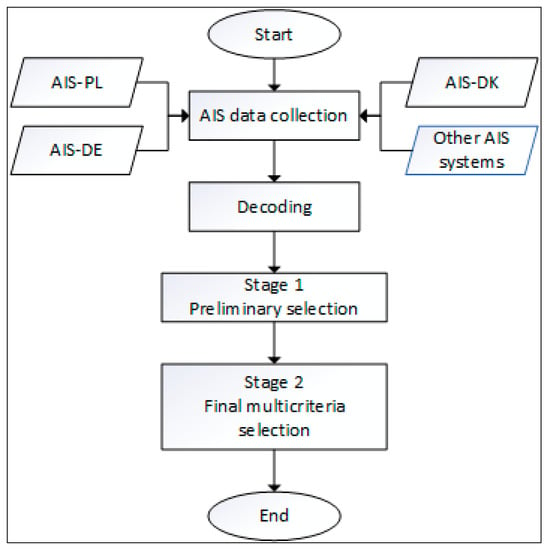
Figure 1.
Algorithm for the selection of vessels for a SAR operation (authors’ own work).
The MCDA methods enable the arrangement of a number of solutions under analysis (in this case, ships) according to predefined criteria. A ranking of vessels can be created sorted by the number of criteria met. What is more, the analysis can be repeated to provide updated data on an ongoing basis. The method is aimed to speed up the selection process and support the coordinator in the demanding task of organisation and coordination of a SAR operation, as well as improve effectiveness of the operation. Additionally, it can become a vital part of a more complex decision support system used by maritime rescue services.
Literature Overview (State of the Art)
Coordination of SAR operations and the inherent necessity of selecting the most suitable vessels for the job is a challenge all over the world. Nonetheless, the multi-criteria approach to the selection of vessels has not been discussed in the literature so far. Planning and coordination of a SAR operation uses numerous criteria, and, on many occasions, the coordinator has a decision support system at their disposal. The selection of vessels for a SAR operation involves acquisition of information about vessels in the vicinity of the distress position and proper communications based on the established procedures and professional experience of coordinators of various levels of a SAR operation [1].
A vast majority of the publications (90%) deal with the planning and conduct of the search activity, i.e., describe results of research into aspects other than those investigated by the authors of this paper. Various approaches to the job of optimal deployment and selection of ships for a SAR operation are discussed by Cameron et al. [2], Azofra et al. [3], Malyszko et al. [4], and Pelot et al. [5]. Lubcke et al. [6] and Shabani et al. [7] focus on optimisation of a SAR operation. Modern challenges and technological advancements in communications systems applied in maritime rescue are analysed by Vlacic et al. [8], Lazaro et al. [9], Gozlan et al. [10], and Yan et al. [11]. Wang et al. [12] describe an innovative approach to missing data filling through multiple imputation. The possibilities of using SAR and AIS to search for and detect vessels are presented in [13,14]. Ship detection using SAR and AIS was discussed in [15]. A novel approach to how to integrate AIS and Synergic Aperture Radar signals and data for vessel traffic and monitoring is presented in [14,16].
2. Materials and Methods
The research is based on data from national automatic identification systems, namely, AIS PL, AIS DE, AIS DK, and AIS SE. The data are saved and made available for retrieval in various standards; therefore, pre-decoding and pre-processing is required as well as filtering out of vessels registered at the same time in multiple systems.
2.1. AIS Data
The AIS uses the VHF (Very High Frequency) radio band. The range of a shipborne system operating within this band varies approximately from 20 to even 60 Nm, depending on the height of antennas and the propagation conditions. Apart from ship’s navigational equipment, aids to navigation both onshore and at sea use the AIS. Objects identified in the AIS can be monitored globally by satellite systems for commercial (e.g., www.exactearth.com, assessed on 3 May 2021) as well as security, military, and other purposes. Domestically, a national AIS system can be used by, e.g., the Vessel Traffic Service (VTS) stations in areas under their surveillance. Moreover, maritime authorities of coastal countries register the AIS data via a network of receivers deployed along the coast and in ports.
The AIS data can be used by both the On-Scene Coordinator onboard the ship and the SAR Mission Coordinator in a shore-based Maritime Rescue Coordination Centre (MRCC). Onboard the ship, data from the AIS are made available through a standard AIS receiver as alphanumerical data, possibly with a mini chart, and through state-of-the-art radars and ARPA systems. Shore-based MRCCs equipped with specialised software and access to global or regional AIS data can analyse the data and pre-select optimal ships for a SAR operation. The data used in the research are from the first quarter of 2021.
The AIS data transmitted by ships and other objects are encoded in the NMEA (National Marine Electronics Association) 0183/2000 standard. The NMEA 0183 Interface Standard, used worldwide across many industry segments, is intended to support one-way serial data transmission from a single talker to one or more listeners (nmea.org). Example data registered in the AIS-PL are shown in Figure 2.
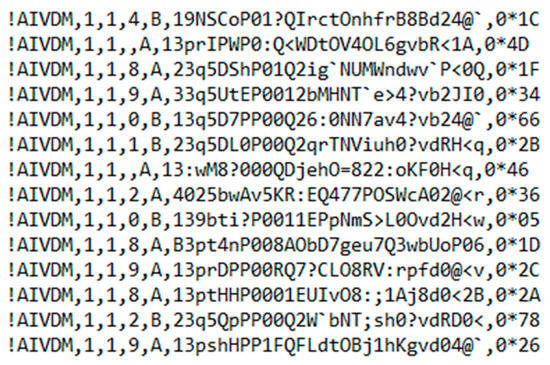
Figure 2.
Extract from original AIS data registered by a shore-based station in the AIS-PL.
As an example, the first line in Figure 2 is to be read as follows:
!—opening mark,
AIVDM—transceiver AIS, encoding standard VDM (VHF Data link Message),
1—number of sequences,
1—AIS channel 1,
4—additional bits,
B—Ais class B,
The following sequence of characters—compressed sequence of data (containing detailed data (inter alia: identification, position, course, speed, ship size),
0*1C—check sum.
In the AIS, data are transmitted from various sources and at different frequencies. In order to select data exclusively from floating surface units, multi-stage filtering was applied to discard data from base stations, aids to navigation, and ships moored in harbors.
2.2. Research Area
The research was carried out based on real-life data. The area under analysis is characterised by dense traffic of all types of ships. A square area of 48 × 48 Nm was selected for the research, where Search and Rescue Regions of Denmark, Germany, Poland, and Sweden have their borders. The data under analysis were recorded at various times of the year, various days of the week, and various times of the day, characterised by different traffic images. The area under analysis has the highest traffic density in the Baltic Sea. Routes to and from major ports of the Baltic Sea as well as the main transit routes cross here. The area has multiple Traffic Separation Schemes (TSS) and is monitored by the AISs of the mentioned countries. A chart of the area under analysis is shown in Figure 3.
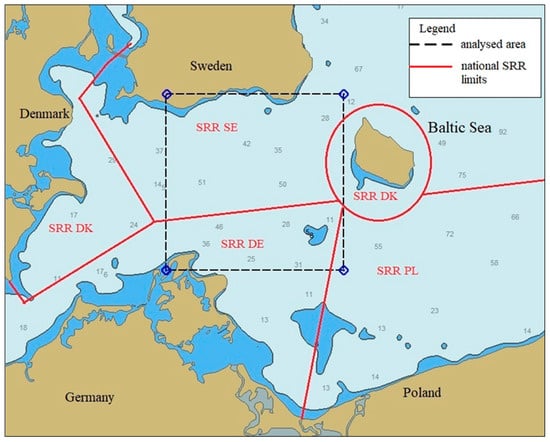
Figure 3.
Area under analysis (authors’ own work).
Part of the text information in the data has been substituted with codes commonly used in sea navigation. Table 1 shows the coding for the ship’s navigational status, Table 2—the type of ship.

Table 1.
Original AIS (NMEA) navigational status of ships and substituting codes.

Table 2.
Original ship type and substituting codes used in AIS (NMEA).
The data were decoded and pre-filtered to discard data from base stations, moored vessels, aids to navigation, AIS-SART transponders, vessels of a length overall smaller than 24 m (considering that their crews may not be qualified for participation in a SAR operation, as well as that they may not be equipped with proper means of communications, lifesaving, and rescue equipment). Example data used in the case study described in this paper, decoded and pre-filtered, are shown in Table 3.

Table 3.
Database (of vessels) based on the AIS data, pre-filtered and decoded (authors’ own work).
where:
- MMSI—Maritime Mobile Service Identity
- Lat—latitude
- Lon—longitude
- Status—navigational status
- SOG—speed over ground (knots)
- COG—course over ground (deg)
- Type—type of ship
- L—ship length (m)
- T—ship draught (m)
- B—ship breadth (m)
The preselected vessels are shown in Figure 4, marked in blue. The simulated distress position φ = 54.95°N, λ = 013.95°E is marked in red.
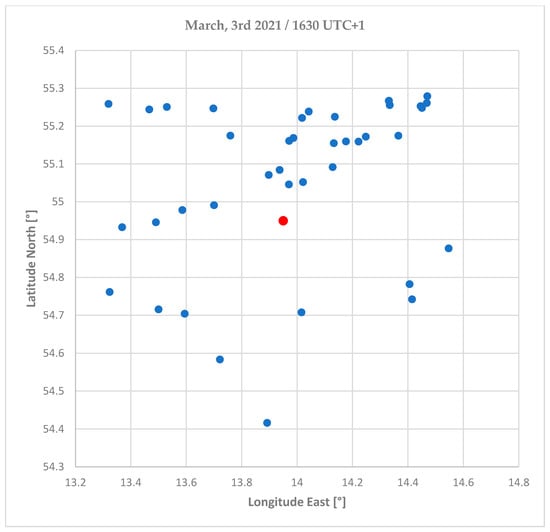
Figure 4.
Positions of pre-selected ships, charted (own work).
2.3. Vessel Selection Algorithm
Once downloaded and decoded, the AIS data were subject to analysis. The authors used one of the MCDA methods—Promethee II (Preference Ranking Organization METHod for Enrichment of Evaluations and its descriptive complement geometrical analysis for interactive aid).
The method uses the outranking relation of alternatives (here, vessels) based on various criteria, sorted in decreasing order, by the preference of the decision maker. The preference function is diluted with the criteria and their weights. The method was elaborated in 1984 by J. Brans [18]. The arguments of each function are differences in the assessment of each pair of alternatives. The function can have a value within the range of zero and one. Values close to zero mean that the preference within a given pair of alternatives is weak or there is no preference at all, whereas values close to one mean that the preference of one of the alternatives is strong. The method uses aggregated preference indices to calculate the outranking flows (domination). A flow can be positive or negative within the range of zero and one. The final result is the net flow of results of the pairwise comparisons. The result of calculations is presented as a partial ranking (Promethee I) or complete ranking (Promethee II).
The Promethee methodology consists of the following steps: building of outranking relations, determination of the preference index, calculation of outranking flows for all variants, determination of the final ranking.
2.3.1. Building of Outranking Relations
An outranking relation is based on a defined set of alternatives (a1, a2, a3 … am), a set of criteria (i1, i2, i3,.. in), weights giving the relative importance of the criteria, and values of the criterion functions. An outranking relation is built on the basis of a preference index , determined with formula (1):
where:
the decision maker’s multi-criteria preference index for alternative a relative to alternative b taking into account all the criteria
—preference function for the ith criterion
i—set of criteria for the evaluation of variants
2.3.2. Determination of the Preference Index
A multi-criteria preference index ) is used to assess the dominance of variant a over variant . The index provides an arrangement of relations between alternatives in a way to enable a comparison to be made within pairs of alternatives, taking into account all the criteria. To determine the index, the preference functions must be determined first. Six types of preference relations are used for this purpose:
- type 1—usual,
- type 2—U-shape,
- type 3—V-shape,
- type 4—level,
- type 5—linear,
- type 6—Gaussian.
Depending on the type of preference function, various evaluation thresholds are in use:
- indifference threshold (q) (the incomparability threshold)—the largest deviation which is considered by the decision maker as negligible. It determines a range of values where no outranging occurs and the minimum function value is 0 (zero);
- preference threshold (p)—the smallest deviation which is considered by the decision maker as sufficient to generate a complete preference. It is the limit value which, if exceeded, generates the maximum value 1 (one) of the preference function;
- Gaussian threshold (σ)—corresponds to the inflection point of the Gaussian curve. It is a deviation of a value between Q and P. More difficult to be determined; the use of the arithmetic mean of the sum of the indifference threshold and the preference threshold is recommended.
Below is a discussion of the usual and linear functions which were used in the simulation.
Type 1—usual preference function
The usual function represents a strong preference and does not have any threshold values (Figure 5.). It corresponds to a situation where for a given criterion, both alternatives (a and b) are considered as equal, i.e., the evaluation values are equal gi(a) = gi(b). If the condition is not met, there is a strong preference of one variant over the other. The function can have one of two values—0 or 1.
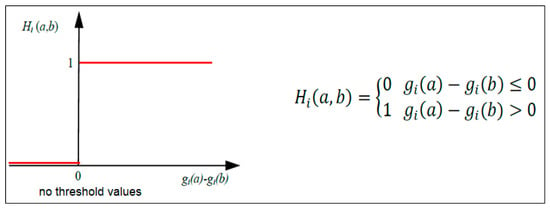
Figure 5.
The ordinary preference function—the Promethee method [3,4].
Type 5—linear preference function
For this function, the indifference threshold q and the preference threshold p must be determined (Figure 6). For a criterion under analysis, the function value increases linearly for the difference in the evaluation of alternatives gi(a)—gi(b); however, the range of the increase is limited by the thresholds. If the difference does not go beyond the indifference threshold q, there is no preference (the function has the value of 0), whereas if the difference goes beyond the preference threshold p, the preference is strong (the function has the value of 1).
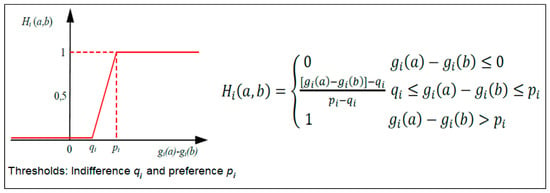
Figure 6.
Linear preference function—the Promethee method [18,19].
2.3.3. Outranking Flows for the Alternatives
Step three consists in the calculation of the value of flows. There are three parameters of the outranking flow: the leaving flow (positive), the entering flow (negative), and the net flow.
The leaving flow Phi+ determines the preference of a given variant over others. The positive preference flow measures how much an alternative a is preferred to the other ones. It is a global measurement of the strengths of alternative a. The larger leaving flow, the better the alternative.
The entering flow Phi- determines the preference of all other variants over a given variant. The negative preference flow measures how much the other alternatives are preferred to alternative a. It is a global measurement of the weaknesses of alternative a. The smaller entering flow the better the alternative.
The net preference flow Phi is the balance between the positive and negative preference flows. It thus takes into account and aggregates both the strengths and the weaknesses of the alternative into a single score. Net flow can be positive or negative. The larger the net flow, the better the alternative.
2.3.4. Building of the Ranking
The ranking of variants (alternatives) is built based on the net flow. Where , variant a is better, preferred over variant b.
2.4. Expert Assessment (Assessment Criteria)
The usefulness of a given vessel in a SAR operation is assessed based on a suitable set of criteria. The criteria meet the coordinator’s expectations concerning the capabilities of vessels necessary to do a certain type of task. The authors developed a set of five criteria, namely, navigational status, time to distress position (transit time), type of vessel, size, and draught. The criteria are measured in various units, i.e., they are expressed qualitatively or quantitatively. Time to distress (transit time) and size are expressed in, respectively, time units and metres, i.e., they represent quantitative criteria, whilst type of vessel and navigational status are expressed qualitatively, by means of a description corresponding to a certain assessment result. Draught, although expressed in metres, is assessed qualitatively at two levels, where the limits of ranges are determined by the coordinator based on the depth of water in a given area. Typically, assessment of criteria expressed in various units of measurement is difficult; however, the MCDA methods solve the problem. Below is a description of the methodology of assessment for particular criteria. Table 4 shows an overview.

Table 4.
Assessment using the ‘navigational status’ criterion [own work].
Navigational status describes the vessel’s temporary situation and indirectly shows whether she can give a quick reaction. There are nine navigational statuses in the AIS, as shown in Figure 3. Status 0—‘underway using engine’, or 8—‘underway sailing’ means that the vessel is able to continue making way using engine or sails. Status 1—‘at anchor’, and 5—‘moored’ means that she will not be able to get underway immediately, as first she has to spend time heaving up anchor or unmooring. Similarly, status 7—‘engaged in fishing’ implies that the fishing gear deployed may prevent the vessel from steering a desired course. Vessels showing status 2—‘not under command’, 3—‘restricted manoeuvrability’, 4—‘constrained by her draught’, and 6—‘aground’ will be assessed as unable to take part in a SAR operation. The classification shown in Table 4 has been adopted to assess vessels using the ‘navigational status’ criterion.
The criterion of draught, expressed in metres, is significant in areas with shallow waters or underwater obstructions. If the coordinator is aware of the specifics of the area (depth, shallows, underwater hazards), he can eliminate ships with excessive draught during the assessment. This criterion is assessed qualitatively Yes/No (1/0), where vessels get 1 point if they are able to navigate in a given area. It should be stressed here that navigation is conducted, supervised, and monitored by the officer of the watch onboard the vessel. However, the criterion of draught is supposed to support the coordinator in the selection of ships and filter out those which most likely will not be able to participate in the operation.
The criterion of size in fact uses the vessel’s length overall (LOA), which is typically correlated with the height of the superstructure. The higher the superstructure is, the better the visual surveillance of the area. This feature is especially appreciated in a search for small objects, such as a survivor in water. This criterion is maximised and assessed quantitatively.
The criterion of time to distress position (transit time) is expressed in time units. This value is determined based on two parameters—speed and distance to the distress position (derived from the vessel’s position). Time to distress position is not equivalent to the estimated time of arrival in the distress position, as it does not take into account such factors as navigational situation or other actions necessary to start navigation (such as heaving up the anchor). The criterion is significant, as it gives us an idea whether the vessel is able to undertake action. Vessels are assessed quantitatively, and the criterion is minimised.
The criterion of the type of vessel provides information about how the vessel is operated. Merchant vessels are the most suitable for the job, as they usually meet the SOLAS and STCW requirements concerning the navigational, communications, and rescue equipment, as well as training of the crew. According to decision makers, with merchant vessels participating in a SAR operation, risk is minimised at maximised effectiveness. With passenger vessels risk is higher considering the presence of many people. The least useful are fishing vessels and pleasure yachts. Most of them do not meet the STCW standards in terms of equipment and qualifications of the crew. Communications problems can be expected (they use shorter range communications equipment) as well as language problems (in some parts of the world). Compared to merchant vessels, the assessment of small vessels in terms of suitability for participation in a SAR operation is poorer. It must be noted here, however, that exceptions may apply.
3. Results
Case Study—Search for a Missing Person
To illustrate how the AIS data can be used, a scenario has been developed and a simulation with the MCDA performed. The authors’ method includes these six steps:
- (1)
- Diagnose the problem (define the decision maker and profile of the SAR operation).
- (2)
- Define the set of alternatives (available Search and Rescue Units, SRU).
- (3)
- Define a consistent set of criteria (and establish the method of assessment).
- (4)
- Model the decision maker’s preferences (determine their expectations).
- (5)
- Carry out the calculation experiment (select the method and carry out the testing).
- (6)
- Summarize (analyze the results and draw a conclusion).
Step 1 consists in the collecting of data on the distress. The most important information includes the type of object in distress and its position, type of assistance required, and the prevailing hydrographical and meteorological conditions. The designation of the coordinator (decision maker) depends on the location of distress. For the purposes of the simulation, the profile of the SAR operation has been determined—searching for a single person in the water. The SAR operation profile is an essential part of the proposed method, as it establishes the relation between the type of distress and the type of assistance required. Weights of particular criteria will vary, depending on the type of operation to be carried out. For each type of operation, the coordinator may be looking for vessels offering different capabilities. For example, when searching for a single person in the water, time to distress and precision of search are of utmost importance. When looking for lifeboats with many survivors, the technical ability to recover many persons is vital. The SAR operation profile is significant at step 4: Model the decision maker’s preferences. In the case under analysis, an area of the Baltic Sea in the Danish SRR was selected, and the distress position 54.95°N 013.95°E as well as the date of the incident 16 March 2021 were established.
Step 2 consists in the establishment of a set of alternatives (decision variants), i.e., ships (SRUs) available in the selected area. The set of alternatives is built through the acquisition of information about vessels in the vicinity of the distress position. They must meet the prerequisite of participating in the SAR operation, i.e., have the status of readiness (including, without limitation, being technically fit and presenting an acceptable risk related to being used in the operation). For this purpose, the AIS was used. A set of 40 vessels which were in the area on the day of simulation under analysis was created (Table 3). This step is discussed in more detail in Section 2.1 and Section 2.2.
The basis for assessment when using the multi-criteria decision support method is the determination of a proper set of criteria (Step 3). Here, the criteria represent features of SRUs sought by the decision maker. The set of criteria includes five features: navigational status, time to distress position (transit time), type of vessel, size of vessel, and draught. The criteria are discussed in Section 2.3.
Step 4 consists in the modelling of the decision maker’s preferences and includes determination of the decision maker’s expectations as preferences concerning the SRUs and the criteria. Modelling of the decision maker’s preferences was carried out with expert studies. The studies took the form of consultation and brainstorming. The expert group consisted of 5 people, including the authors. The preferences are expressed as weights of the criteria and sensitivity to a change in the criteria. The parameters established for the situation under analysis are shown in Figure 7. Weights of the criteria, determined by experts, vary between 10% and 30%. The experts considered navigational status and time to distress position (transit time) to be equally important and the most relevant in the set of criteria. Searching for and recovering a person from the water requires a quick response because of the risk of hypothermia and drowning. Therefore, vessels which are able to proceed immediately to the scene of the incident and those which can get there fastest are most desirable to the co-ordinator. Type of vessel and size of vessel were considered to have less influence on the possibility to reach success but are still important. The draught of the vessel was ranked last because it has no influence on the outcome of the action, but on the ability to participate in the action. The usual preference function was defined for the criteria of navigational status, type of vessel, and draught, whilst the linear preference function was defined for the time to distress (transit time) and size of vessel. It is usually recommended that qualitative criteria have a usual function and quantitative criteria have a linear function. This was also chosen in this case. Only the draught criterion will be evaluated in a different way to take into account the current conditions in the search area., The following thresholds (indifference and preference) were established for the linear function: transit time criterion (0.25 h and 1 h), vessel size criterion (40 m and 200 m). This means that in the first case (usual function), the alternative with a higher value will automatically receive 1 point. In the other case (linear function): where the difference between the assessment of two alternatives is below the indifference threshold, both alternatives will receive the same score (they are equally good for the decision maker, i.e., a difference in the time to distress (transit time) of less than 0.25 h is considered negligible by the decision maker). If the difference between the assessment of two alternatives is between the two thresholds, the better alternative will receive a value, in proportion, between 0 and 1. Once the difference goes beyond the preference threshold, the better alternative will automatically receive 1 point. Thresholds for time were determined based on the specifics of the simulated search area. Thresholds for vessel size were established on the basis of an analysis of average vessel parameters.
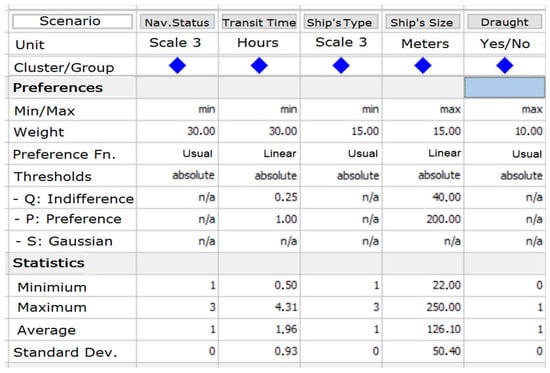
Figure 7.
Visual Promethee software dialogue window: criterion weight, preference function, preference threshold for the defined set of criteria (own work on the basis of the Visual Promethee software).
Step 5 consists in the selection of appropriate calculation methods and information processing (testing). The case under analysis uses the Promethee II method. The data acquired in steps 1–4 were implemented into the algorithm. In the case under analysis, the Visual Promethee software was used for this simulation. The database for the scenario was filled in with the data on each SRU for each of the criteria. Here, the data were entered manually. Ultimately, in more advanced decision support systems for SAR operations, the data can be entered automatically. The results were analysed in the subsequent step.
Step 6 consists in an analysis of the results and their sensitivity, to be able to establish reliability of the result. The results enable us to create a ranking of alternatives (vessels, from the best to the worst, according to the Phi net value). The following ranking was obtained in the scenario under analysis (Figure 8): Vessel 03 ranked the highest (Phi = 0.314), Vessel 35 ranked the lowest (Phi = −0.7807). What is interesting, results for vessels at the top of the list do not vary much. It means that the coordinator is able to isolate a group of vessels which can perform search and rescue tasks equally well. Otherwise, the coordinator can decide to choose the vessel at the very top of the list. The ranking is supposed to support the coordinator. An additional single-criterion analysis can help us determine which vessels can be useful in a given SAR operation.
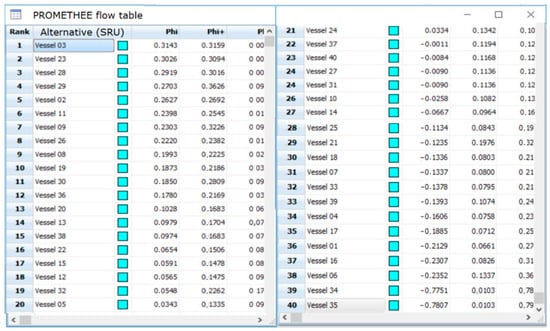
Figure 8.
Net flows—a ranking of alternatives (own work on the basis of the Visual Promethee software).
All things considered, the data provided by the AIS are limited and do not provide exhaustive information on ships. Therefore, in the next step, the coordinator can decide to contact selected vessels to establish details. Nevertheless, the ranking will facilitate the task and speed up the decision-making process, and, first and foremost, provide a pre-selection according to the coordinator’s preferences.
An alternative manner to present the data is offered by the Promethee Network. This tool enables a quick data analysis taking into account the Phi net flows (sorted vertically—the final result of a multi-criteria analysis) as well as the partial rankings Phi+ and Phi–, which have an impact on the horizontal arrangement. The alternatives closer to the left edge of the network have smaller negative values, i.e., have been assessed higher in the single-criterion assessment than those located to the right. For example, Vessel 29 has a relatively high net flow, similarly to Vessel 28 (both of them are high on the vertical axis of the graph); however, Vessel 29 is to the right of Vessel 28, which means that it is assessed worse than Vessel 28 according to one of the criteria. A closer analysis of the data for both vessels reveals that it is the criterion of draught. Using the network, the decision maker can easily create a group of optimal vessels by selecting those located in the top left-hand corner (Figure 9: for example, a bounded by Vessel 03 and Vessel 36, skipping Vessels 29, 09, and 30).

Figure 9.
Promethee network (own work on the basis of the Visual Promethee software).
As mentioned before, data available from the AIS are limited and do not cover all vessel parameters which may be useful in a SAR operation. Therefore, the coordinator will most probably verify and complete their information about a vessel via radiotelephony. However, by applying a multi-criteria analysis, we can easily pre-select vessels which best meet our needs. Some other modern methods are described in [20,21,22,23].
To summarise the case study, the following can be pointed out:
- the action profile was defined (search for one person in the water);
- the search area was determined;
- a group of alternatives was defined (information about the ships was obtained from the AIS system, the data were decoded, several parameters of the ships were obtained; the parameters are used to assess the suitability of the ship for the search and rescue operation;
- a set of criteria and a method of evaluation was defined; modelling of the decision maker’s preferences was carried out; the criteria have weights, evaluation limits, and evaluation thresholds;
- a multi-criteria decision analysis computational experiment was conducted (Promethee II method was performed);
- the results were analysed in the form of a table and a network;
- a way of the final selection of ships for action was suggested.
4. Discussion and Conclusions
The authors propose a way to optimise the planning and coordination of SAR operations with the use of AIS data through boosting the effectiveness of selection of non-rescue vessels to participate in SAR operations. A detailed analysis of vessels is made with the use of the MCDA methods, which enable us to examine vessels based on multiple criteria simultaneously. One of the advantages of the method is the ability to sort a set of vessels under analysis by the decision maker’s preference. Such a method of analysis provides tools for rapid isolation of ships which meet the decision maker’s requirements. The authors make an assumption that the proposed method will become part of the systems supporting captains (coordinators) in the decision-making process in emergencies.
The use of the AIS data is relatively inexpensive, as it is based on systems and equipment which are already in place. The data analysis is rapid and comprehensive. The feature of data filtering enables the exclusion of vessels which do not meet the basic criteria (e.g., vessels with a draught which is too big for the area of the operation). The AIS is easily accessible in areas offering Internet access, without the need to have one’s own transmitter. A downside to the method is that the quality or quantity of incoming data cannot be controlled. A small percentage of the data have coding errors, what may impair rapid data analysis.
The application of the MCDA method requires the involvement of the decision-maker (experts). Their opinion on the details of the action and their preference for ships are essential. Defining the right criteria and modelling the decision maker’s preferences significantly affect the results. During the preparation of the study, several computational simulations were performed for different action profiles. In this paper one case study (search for missing person) is presented. The action profile defines the relationship between the type of danger and the type of assistance required. For each action profile, the decision maker’s preferences have to be modelled. This is because different types of operations require different resources. A given ship may be very useful in a particular action and not very suitable for another. The role of the decision maker (RCC coordinator) is to select the most suitable units for the action. He or she must rely on the information received, his or her own judgement and experience. This task is very stressful. It is easy to make mistakes or unnecessarily prolong the decision time. The situation of selecting non-rescue vessels for action is not an everyday problem in the RCC. However, to support the coordinator, the authors propose the introduction of a decision support system. One of its modules could be the selection of units in order to choose optimal ships. In this way, it will be possible to improve the effectiveness of the action.
The method is especially useful in areas of high traffic density, where ships are of various types, with different equipped and carrying out different tasks. Likely, many of them will be less suitable than others to carry out a SAR operation. In many areas, especially upon the open oceans, vessel traffic may be scarce and no comparison between vessels may be needed when conducting a SAR operation. Nevertheless, the data gathered even in such circumstances can be used later to build ship databases and determine their possible effectiveness in a SAR operation.
Author Contributions
Conceptualization, M.W., M.M.; methodology, M.W., M.M.; simulation research and data analysis software, M.W., M.M.; validation, M.W., M.M.; formal analysis, M.M.; investigation, M.W., M.M.; resources, M.W.; data curation, M.W., M.M.; writing—original draft preparation, c writing—review and editing, M.W.; visualization, M.W., M.M.; supervision and funding acquisition, M.W., M.M. Both authors have read and agreed to the published version of the manuscript.
Funding
This research outcome has been achieved under the research project 1/S/KRiZR/21 financed from a subsidy of the Ministry of Science and Higher Education for statutory activities of the Maritime University of Szczecin.
Institutional Review Board Statement
Not applicable.
Informed Consent Statement
Not applicable.
Data Availability Statement
Publicly available datasets were analyzed in this study. This data can be found here: https://www.dma.dk/SikkerhedTilSoes/Sejladsinformation/AIS/Sider/default.aspx (accessed on 20 March 2021).
Conflicts of Interest
The authors declare no conflict of interest.
References
- IMO. International Aeronautical and Maritime Search and Rescue Manual; International Maritime Organization: London, UK, 2019; Volume III. [Google Scholar]
- Cameron, A.; Pelot, R.; Nguyen, B.; Ng, K. Modeling Canadian search and rescue operations. Mil. Oper. Res. 2000, 5, 5–16. [Google Scholar]
- Azofra, M.; Perez-Labajos, C.; Blanco, B.; Achutegui, J. Optimum placement of sea rescue resources. Saf. Sci. 2007, 45, 941–951. [Google Scholar] [CrossRef]
- Małyszko, M.; Bugajski, G.; Wielgosz, M. Wykorzystanie systemu AIS do selekcji i doboru jednostek nieratowniczych do akcji SAR (Using the AIS system to select non-professional rescue units for SAR operations). Autobusy 2017, 12, 276–280. (In Polish) [Google Scholar]
- Pelot, R.; Akbari, A.; Li, L. Vessel location modeling for maritime search and rescue. In Applications of Location Analysis; International Series in Operations Research & Management Science; Eiselt, H., Marianov, V., Eds.; Springer: Cham, Switzerland, 2015; Volume 232. [Google Scholar] [CrossRef]
- Lübcke, T.; Steigenberger, N.; Bornhorst, C.; Roßner, P. Inter-organizational simulation as a training opportunity for maritime search and rescue (SAR) missions. In Proceedings of the 7th International Conference on Applied Human Factors and Ergonomics (AHFE), Orlando, FL, USA, 27–31 July 2016. [Google Scholar]
- Shabani, A.; Asgarian, B.; Salido, M.; Gharebaghi, S.A. Search and rescue optimization algorithm: A new optimization method for solving constrained engineering optimization problems. Expert Syst. Appl. 2020, 161, 113698. [Google Scholar] [CrossRef]
- Valcic, S.; Mrak, Z.; Gulić, M. Analysis of advantages and disadvantages of existing maritime communication systems for data exchange. Sci. J. Maritime Res. 2016, 30, 28–37. [Google Scholar] [CrossRef]
- Lázaro, F.; Raulefs, R.; Wang, W.; Clazzer, F.; Plass, S. VHF Data Exchange System (VDES): An enabling technology for maritime communications. CEAS Space J. 2019, 11, 55–63. [Google Scholar] [CrossRef] [Green Version]
- Gözlan, A.; John, O.; Lübcke, T.; Maier, A.; Reimann, M.; Richter, J.-G.; Zvarev, I. Assisting Maritime Search and Rescue (SAR) Personnel with AI-Based Speech Recognition and Smart Direction Finding. JMSE 2020, 8, 818. [Google Scholar] [CrossRef]
- Yan, Z.; Xiao, Y.; Cheng, L.; He, R.; Ruan, X.; Zhou, X.; Li, M.; Bin, R. Exploring AIS data for intelligent maritime routes extraction. Appl. Open Res. 2020, 101. [Google Scholar] [CrossRef]
- Wang, G.; Ma, M.; Jiang, L.; Chen, F.; Xu, L. Multiple imputation of maritime search and rescue data at multiple missing patterns. PLoS ONE 2020, 16, e0252129. [Google Scholar] [CrossRef] [PubMed]
- Hou, X.; Ao, W.; Song, Q.; Lai, J.; Wang, H.; Xu, F. FUSAR-Ship: Building a high-resolution SAR-AIS matchup dataset of Gaofen-3 for ship detection and recognition. Sci. China Inf. Sci. 2020, 63, 140303. [Google Scholar] [CrossRef] [Green Version]
- Galdelli, A.; Mancini, A.; Ferra, C.; Tassettti, A.N. A Synergic Integration of AIS Data and SAR Imagery to Monitor Fisheries and Detect Suspicious Activities. Sensors 2021, 21, 2756. [Google Scholar] [CrossRef] [PubMed]
- Marino, A.; Sanjuan-Ferrer, M.J.; Hajnsek, I.; Ouchi, K. Ship Detection with Spectral Analysis of Synthetic Aperture Radar: A Comparison of New and Well-Known Algorithms. Remote Sens. 2015, 7, 5416–5439. [Google Scholar] [CrossRef]
- Graziano, M.D.; Renga, A.; Moccia, A. Integration of Automatic Identification System (AIS) Data and Single-Channel Synthetic Aperture Radar (SAR) Images by SAR-Based Ship Velocity Estimation for Maritime Situational Awareness. Remote Sens. 2019, 11, 2196. [Google Scholar] [CrossRef] [Green Version]
- Available online: https://www.nmea.org (accessed on 26 February 2021).
- Brans, J.; Mareschal, B.; Vincke, P. Promethee: A new family of outranking methods in multicriteria analysis. Oper. Res. 1984, 3, 408–421. [Google Scholar]
- Brans, J.; Vincke, P.; Mareschal, B. How to select and how to rank projects. The Promethee method. Eur. J. Oper. Res. 1986, 24, 228–238. [Google Scholar] [CrossRef]
- Bugajski, G.; Małyszko, M.; Wielgosz, M. Analysis of parameters influencing the suitability of the surface unit for search and rescue operation at sea. Sci. J. 2018, 125. [Google Scholar] [CrossRef]
- Li, C.; Chen, F.; Qi, F.; Liu, M.; Li, Z.; Liang, F.; Jing, X.; Lu, G.; Wang, J. Searching for Survivors through Random Human-Body Movement Outdoors by Continuous-Wave Radar Array. PLoS ONE 2016, 11, e0152201. [Google Scholar] [CrossRef]
- Vieira, F.M.; Vincent, F.; Tourneret, J.; Bonacci, D.; Spigai, M.; Ansart, M.; Richard, J. Ship Detection Using SAR and AIS Raw Data for Maritime Surveillance. In Proceedings of the 24th European Signal Processing Conference (EUSIPCO), Budapest, Hungary, 29 August–2 September 2016. [Google Scholar]
- Baber, C.; Stanton, N.A.; Atkinson, J.; McMaster, R.; Houghton, R.J. Using social network analysis and agent-based modelling to explore information flow using common operational pictures for maritime search and rescue operations. Ergonomics 2013, 56, 889–905. [Google Scholar] [CrossRef] [PubMed]
Publisher’s Note: MDPI stays neutral with regard to jurisdictional claims in published maps and institutional affiliations. |
© 2021 by the authors. Licensee MDPI, Basel, Switzerland. This article is an open access article distributed under the terms and conditions of the Creative Commons Attribution (CC BY) license (https://creativecommons.org/licenses/by/4.0/).